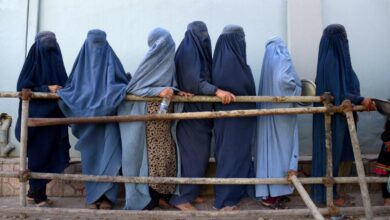The Evolution of Forced Labour in Xinjiang
The evolution of forced labour in Xinjiang is a complex and disturbing issue. It’s a story woven from historical threads of coerced labor, evolving government policies, and the devastating experiences of countless individuals. This exploration delves into the economic drivers, international responses, and the profound impact on human rights and social structures within the region, painting a picture of a deeply troubling situation demanding urgent attention.
We’ll examine the historical context, tracing the transformations in labor practices from earlier forms of coercion to the current allegations of systematic forced labor. We’ll analyze the role of government policies and regulations, scrutinizing their impact on the lives of those affected. The narrative will also explore the economic incentives behind these practices, their place within global supply chains, and the international community’s responses, including sanctions and diplomatic efforts.
Finally, we’ll consider the devastating human rights consequences and the long-term social implications of this ongoing crisis.
Historical Context of Forced Labor in Xinjiang
Understanding the current allegations of forced labor in Xinjiang requires examining the region’s complex history of labor practices. While contemporary accusations focus on large-scale, state-sponsored programs, the reality is far more nuanced, encompassing a long history of both voluntary and coerced labor under various regimes. Analyzing this evolution helps contextualize the current situation and avoid simplistic narratives.
Xinjiang’s historical labor practices have been shaped by its geographical location, diverse ethnic groups, and fluctuating political climates. For centuries, the region relied heavily on agriculture, pastoralism, and resource extraction, often involving forms of labor that, while not always explicitly “forced,” often lacked the protections and freedoms associated with modern labor standards. The harsh environment and limited infrastructure contributed to precarious economic conditions for many, making them vulnerable to exploitation.
Pre-existing Coerced Labor Practices
Prior to the establishment of the People’s Republic of China (PRC) in 1949, Xinjiang experienced various forms of coerced labor. These included forms of indentured servitude, particularly amongst marginalized communities, and the exploitation of labor in resource extraction projects under both local rulers and foreign concessions. These practices were often tied to ethnic and social hierarchies, with certain groups disproportionately bearing the burden of harsh labor conditions.
While systematic data on the scale of this pre-PRC coerced labor is scarce, anecdotal evidence and historical accounts suggest it was a significant feature of the region’s economy.
State-Sponsored Labor Programs Under the PRC
Following the PRC’s establishment, the Chinese government implemented various state-sponsored labor programs in Xinjiang, often framed within the context of socialist development and modernization. These programs, while officially voluntary, sometimes involved elements of coercion, particularly during periods of political mobilization and social upheaval. Examples include large-scale infrastructure projects, such as the construction of roads and irrigation systems, which frequently relied on a significant amount of manual labor, often under demanding conditions.
These programs, while contributing to the region’s development, also created potential for exploitation and the marginalization of certain communities.
Comparison of Historical and Contemporary Allegations
Comparing historical labor practices with contemporary allegations reveals key differences and continuities. While pre-PRC forms of coerced labor were often less systematic and state-directed, contemporary allegations point to a more organized and centralized system involving mass internment, restrictions on movement, and the forced transfer of individuals to factories and other work sites. The scale and alleged level of state involvement in contemporary accusations represent a significant departure from previous practices.
However, the historical context of vulnerability and exploitation within Xinjiang’s economy helps to understand how such a system might develop and persist.
Timeline of Significant Events and Policy Changes Related to Labor in Xinjiang
A chronological overview of key events is crucial to understanding the evolution of labor practices in Xinjiang. Precise dates and details are often contested, but a general timeline can highlight significant shifts.
| Date | Event/Policy | Significance |
|---|---|---|
| Pre-1949 | Various forms of indentured servitude and exploitation in resource extraction. | Established a pattern of vulnerable labor practices in the region. |
| 1949-1978 | Implementation of socialist labor programs; often involving significant manual labor in infrastructure projects. | State involvement in labor practices intensified. |
| Post-1978 (Reform and Opening Up) | Shift towards market-oriented economy; increased foreign investment and industrialization. | Created new opportunities for both economic growth and exploitation. |
| 2010s – Present | Implementation of “poverty alleviation” programs and mass internment; allegations of forced labor in factories and other industries. | Marks a significant escalation in scale and alleged state-sponsored coercion. |
The Role of Government Policies and Regulations
The Chinese government’s policies and regulations in Xinjiang have been the subject of intense scrutiny, with allegations of forced labor playing a central role in international criticism. Understanding these policies and their implementation is crucial to assessing the extent and nature of these allegations. While the Chinese government denies the existence of forced labor, the policies themselves have been interpreted by many as contributing to conditions that facilitate such exploitation.The interplay between stated economic development goals, security concerns, and the implementation of specific regulations creates a complex environment where the lines between voluntary and coerced labor become blurred.
This section will examine key government policies and their potential impact on labor practices within the Xinjiang Uyghur Autonomous Region (XUAR).
Government Policies and Regulations Related to Labor in Xinjiang
Several government policies and regulations, ostensibly aimed at poverty alleviation and economic development, have been linked to allegations of forced labor. These policies often focus on vocational training, employment schemes, and the integration of Uyghur populations into the broader Chinese economy. However, critics argue that these programs are implemented in a manner that restricts individual choice and freedom of movement, creating an environment conducive to forced labor.
The evolution of forced labor in Xinjiang is a horrifying example of modern-day slavery, a stark contrast to the seemingly distant conflict detailed in this article about Israel and the Houthis trading bombs and bluster. While geographically and seemingly thematically disparate, both situations highlight the devastating impact of power imbalances and the urgent need for global accountability.
Understanding the complexities of Xinjiang’s forced labor requires recognizing the broader context of global human rights violations.
The lack of transparency surrounding these programs further exacerbates concerns.
Key Legal Frameworks and Their Impact
China’s labor laws, while existing on paper, are often criticized for weak enforcement, particularly in regions like Xinjiang. The existing legal frameworks, designed to protect workers’ rights, may not adequately address the unique challenges and alleged abuses in the XUAR. The application of these laws, or the lack thereof, is a key factor in determining the extent to which forced labor is prevalent.
For example, while laws exist concerning minimum wage, working hours, and contract agreements, their effective implementation in the context of large-scale government-led projects and the alleged suppression of worker advocacy remains questionable.
Enforcement Mechanisms and Their Effectiveness
The effectiveness of enforcement mechanisms in preventing labor exploitation in Xinjiang is a major point of contention. While the Chinese government maintains robust oversight systems, critics argue that these mechanisms are primarily focused on maintaining social order and political control rather than genuinely protecting worker rights. The lack of independent monitoring and the restrictions on access for international observers further hinder the assessment of the effectiveness of these mechanisms.
Allegations of widespread surveillance and intimidation of workers who might report abuses also contribute to the lack of effective enforcement.
Table of Relevant Legal Documents and Policies
| Policy Name | Year Implemented | Key Provisions | Enforcement Mechanisms |
|---|---|---|---|
| (Example: Poverty Alleviation Program in Xinjiang) | (Example: 2014) | (Example: Relocation of rural populations to urban areas for employment; vocational training programs) | (Example: Local government oversight; performance evaluations based on employment rates; limited independent monitoring) |
| (Example: National Vocational Skills Improvement Plan) | (Example: 2019) | (Example: Emphasis on vocational training and skills development; targets for employment in specific industries) | (Example: National and regional government agencies; inspections; limited reporting mechanisms) |
| (Example: Regulations on Labor Contracts) | (Example: Ongoing) | (Example: Specifies terms of employment, working conditions, and dispute resolution processes) | (Example: Labor bureaus; courts; limited worker protections in practice) |
The Experiences of Affected Populations
The accounts of individuals allegedly subjected to forced labor in Xinjiang paint a grim picture of human rights abuses. These experiences are diverse, reflecting the varied backgrounds and vulnerabilities of those affected, but share common threads of coercion, exploitation, and deprivation. Understanding these individual narratives is crucial to fully grasping the scale and impact of the alleged forced labor system.The experiences of those allegedly forced into labor are complex and multifaceted, varying significantly depending on factors such as ethnicity, location, and the specific factory or farm involved.
While precise numbers remain difficult to ascertain due to information restrictions, reports from various human rights organizations and journalistic investigations paint a consistent picture of widespread abuse.
Backgrounds and Vulnerabilities of Affected Individuals
Many of those allegedly subjected to forced labor come from vulnerable communities within Xinjiang, including Uyghurs, Kazakhs, and other ethnic minority groups. Pre-existing socio-economic disadvantages, limited access to education and employment opportunities, and the pervasive state surveillance often left them with little recourse when faced with forced labor assignments. Furthermore, family separation and the lack of independent legal avenues for redress exacerbated their vulnerabilities.
Many individuals were reportedly taken from their homes and families with little or no warning, leaving them isolated and helpless in the face of forced labor. Their lack of knowledge of Mandarin and limited literacy in any language often hindered their ability to understand their rights or seek help.
Types of Work, Conditions, and Compensation
Allegations suggest a wide range of forced labor assignments, from picking cotton in vast fields under harsh conditions to working in factories producing textiles, electronics, and other goods. Reports consistently describe grueling work schedules, inadequate food and housing, and a complete lack of worker protections. Compensation, when provided at all, was often minimal and far below the legal minimum wage.
Many individuals were subjected to intense surveillance, with limited contact with the outside world, including their families. This control was further intensified by the presence of security personnel and the constant threat of punishment for non-compliance.
The horrifying evolution of forced labor in Xinjiang, a stain on the 21st century, demands a strong global response. We need decisive leadership to confront this atrocity, and I’m starting to question if the current administration is up to the task; read this article arguing that joe biden should now give way to an alternative candidate who might bring a more effective approach.
The urgency of addressing the systematic oppression in Xinjiang cannot be overstated, demanding immediate and sustained action from whoever holds the reins of power.
Comparison of Accounts Across Different Groups
While the overall experiences share similarities, nuances exist between the accounts of different groups. For example, women often faced additional challenges, including sexual harassment and exploitation. Younger individuals might have been subjected to more intense indoctrination and surveillance, while older individuals might have experienced greater health challenges due to the demanding work conditions. Despite these variations, the common thread remains: a system of forced labor built on coercion, exploitation, and the denial of basic human rights.
A Typical Day in the Life of an Allegedly Forced Laborer
Imagine a typical day for a young Uyghur woman, Amina, allegedly forced to work in a cotton field. She wakes before dawn to the shrill sound of a whistle, joining hundreds of other laborers for a meager breakfast of bread and watery tea. The day unfolds under the relentless Xinjiang sun, picking cotton from sunrise to sunset with minimal breaks.
The horrifying evolution of forced labor in Xinjiang, a stain on the 21st century, demands global attention. Understanding the complexities of such systemic oppression requires looking at how international pressure manifests, and this year, the way the American presidential debates are changing, as detailed in this insightful article how americas presidential debates are changing this year , might offer clues to future policy shifts.
Ultimately, the fight against this injustice hinges on consistent global pressure and accountability. The situation in Xinjiang needs constant monitoring.
The work is backbreaking, the food is barely enough, and the constant surveillance leaves her feeling trapped and hopeless. At night, she shares a cramped dormitory with dozens of other women, their anxieties and fears palpable in the silence. She longs for her family, but communication is strictly controlled, leaving her feeling isolated and alone. This is not a unique story; it reflects the harsh realities faced by countless individuals allegedly subjected to forced labor in Xinjiang.
Economic Drivers and Incentives
The alleged use of forced labor in Xinjiang is a complex issue interwoven with economic incentives, creating a system where profit often outweighs human rights. Understanding these economic drivers is crucial to comprehending the scale and persistence of these practices. The interplay between government policies, global demand, and the structure of Xinjiang’s economy has created a fertile ground for exploitation.The economic incentives driving the alleged use of forced labor in Xinjiang stem from a confluence of factors, primarily the pursuit of cheap labor and the fulfillment of high global demand for specific products.
The cost savings associated with exploiting vulnerable populations, including Uyghurs and other ethnic minorities, are significant, offering substantial profit margins for businesses involved. This cost advantage allows businesses to undercut competitors and capture larger market shares, particularly in industries with tight margins and high production volumes.
Industries and Sectors Implicated in Forced Labor
Several industries in Xinjiang are heavily implicated in allegations of forced labor. The cotton industry, a cornerstone of Xinjiang’s economy, is perhaps the most widely known. Reports suggest that significant portions of Xinjiang’s cotton harvest rely on the forced labor of Uyghurs and other ethnic minorities. Beyond cotton, other sectors, including garment manufacturing, food processing, and the production of solar panels and other electronics components, have also faced allegations of forced labor practices.
These industries often rely on extensive supply chains that span the globe, making it challenging to trace the origins of goods and identify the presence of forced labor. The scale of these operations, combined with weak regulatory oversight, has enabled the alleged exploitation to persist.
The Role of Global Supply Chains and Consumer Demand
Global supply chains play a critical role in perpetuating the alleged use of forced labor in Xinjiang. Many multinational companies source raw materials, such as cotton, from Xinjiang, often indirectly through complex networks of suppliers and subcontractors. The opacity of these supply chains makes it difficult to track the origins of goods and ensure that they are not produced using forced labor.
High consumer demand for inexpensive goods further fuels this system. The pressure to meet consumer expectations for low prices often incentivizes companies to seek out the cheapest possible sources of labor, regardless of ethical considerations. This creates a market dynamic where forced labor becomes a competitive advantage.
Economic Impact of Forced Labor
The economic impact of forced labor in Xinjiang is multifaceted and extends beyond the immediate region.
- Suppressed Wages and Reduced Worker Rights: The use of forced labor drastically suppresses wages and eliminates worker rights, leading to significant economic losses for the affected populations.
- Undermining Fair Competition: Businesses utilizing forced labor gain an unfair competitive advantage, harming businesses that adhere to ethical labor practices.
- Reputational Damage and Consumer Boycotts: Allegations of forced labor have damaged the reputation of Xinjiang’s products and led to consumer boycotts, impacting export revenues.
- Long-Term Economic Instability: The reliance on forced labor creates a system that is unsustainable in the long term and undermines the potential for genuine economic growth in Xinjiang.
- Global Market Disruptions: The presence of forced labor in global supply chains disrupts markets and undermines consumer trust in the integrity of products.
International Responses and Sanctions: The Evolution Of Forced Labour In Xinjiang
The allegations of forced labor in Xinjiang have sparked a significant international response, ranging from diplomatic pressure to targeted sanctions. The international community’s reaction reflects a complex interplay of geopolitical considerations, human rights concerns, and economic interests. While the effectiveness of these measures remains a subject of debate, their existence underscores the global gravity of the situation.The response has been far from uniform, with varying degrees of engagement from different countries and international organizations.
Some nations have taken a strong stance, imposing sanctions and publicly condemning the alleged abuses, while others have adopted a more cautious approach, prioritizing economic ties with China. The resulting patchwork of responses highlights the challenges in achieving a unified global front on this complex issue.
Sanctions Imposed by Various Countries and International Organizations
Several countries and international organizations have implemented sanctions targeting individuals and entities allegedly involved in the forced labor practices in Xinjiang. These sanctions typically involve asset freezes, travel bans, and restrictions on trade. The aim is to exert economic pressure and encourage reforms.
| Country/Organization | Action Taken | Date (Approximate) | Outcome |
|---|---|---|---|
| United States | Various sanctions targeting individuals and entities, including import bans on goods produced with forced labor. | 2019-2023 (ongoing) | Limited impact reported, but symbolic condemnation and some disruption to targeted supply chains. China has retaliated with its own sanctions. |
| European Union | Sanctions targeting individuals and entities, including travel bans and asset freezes. | 2021 | Similar to US sanctions, the impact is debated. The EU continues to monitor the situation and engage in diplomatic efforts. |
| Canada | Sanctions targeting individuals and entities, similar to the US and EU actions. | 2021-2023 (ongoing) | Impact debated, but contributes to international pressure. |
| United Kingdom | Sanctions targeting individuals and entities. | 2021-2023 (ongoing) | Impact debated, but contributes to international pressure. |
| Australia | Sanctions targeting individuals and entities. | 2021-2023 (ongoing) | Impact debated, but contributes to international pressure. |
| UN Human Rights Council | Reports and resolutions expressing concern and calling for investigations. | Ongoing | Limited direct impact in terms of sanctions, but contributes to international awareness and pressure. Access to Xinjiang for independent investigation remains severely restricted. |
Effectiveness of International Measures, The evolution of forced labour in xinjiang
The effectiveness of international responses to forced labor allegations in Xinjiang remains a subject of ongoing debate. While sanctions and diplomatic pressure have raised awareness and put some pressure on China, their overall impact on ending forced labor practices is difficult to definitively assess. The lack of independent access to Xinjiang significantly hinders monitoring and verification efforts. Furthermore, China’s economic clout and its strategic importance in global affairs complicate the ability of international actors to effectively enforce sanctions or leverage significant consequences.
The retaliatory sanctions imposed by China further illustrate the complex geopolitical dynamics at play. Many argue that a more coordinated and comprehensive approach, potentially involving stronger economic leverage and a more unified international stance, is needed to achieve tangible improvements.
The Impact on Human Rights and Social Structures
The forced labor regime in Xinjiang represents a profound violation of fundamental human rights, leaving deep scars on individuals, families, and the entire social fabric of the region. The systematic nature of these abuses, coupled with the suppression of dissent and independent reporting, makes assessing the full extent of the damage a challenging but crucial task. The consequences extend far beyond economic exploitation, impacting cultural identity, family structures, and the very sense of community in Xinjiang.The human rights violations associated with forced labor are extensive and well-documented.
They encompass a wide range of abuses, from the denial of freedom of movement and association to physical and psychological coercion, and the deprivation of fair wages and safe working conditions. Reports consistently cite instances of arbitrary detention, torture, and sexual violence, perpetrated against those subjected to forced labor, often within the context of the expansive network of internment camps.
The systematic nature of these abuses underscores a deliberate effort to suppress Uyghur identity and culture.
Human Rights Violations
The forced labor system in Xinjiang systematically violates numerous internationally recognized human rights. These violations include but are not limited to the right to freedom of movement, the right to work freely, the right to a fair wage, the right to freedom from torture and cruel, inhuman, or degrading treatment, the right to freedom of religion, the right to freedom of expression, and the right to an adequate standard of living.
These violations are often intertwined and mutually reinforcing, creating a climate of fear and oppression that prevents individuals from exercising their basic rights. The lack of independent oversight and accountability further exacerbates the situation.
Impact on Social Fabric
Forced labor has severely disrupted the social fabric of Xinjiang’s communities. The mass detention and forced labor of significant portions of the Uyghur population have shattered families and eroded traditional social support systems. The separation of parents from children, siblings from each other, and spouses from one another has created immense emotional trauma and long-term psychological damage. Traditional community structures, based on kinship and religious practices, have been undermined by the systematic disruption of family life and the suppression of cultural and religious expression.
This has created a sense of instability and fear, making it difficult for communities to rebuild and recover.
Long-Term Consequences
The long-term consequences of forced labor in Xinjiang are profound and far-reaching. For individuals, the trauma of forced labor, separation from family, and cultural suppression can lead to lifelong psychological and emotional distress. The economic hardship caused by the loss of livelihoods and the inability to support families has far-reaching consequences for individuals and future generations. For society as a whole, the erosion of trust in institutions, the destruction of community structures, and the suppression of cultural identity have created a deep sense of instability and uncertainty.
The long-term impact on social cohesion and economic development remains a significant concern.
Visual Representation of Social and Human Rights Impacts
Imagine a vibrant tapestry depicting the rich cultural heritage of Xinjiang, with its intricate patterns and diverse colors representing the various ethnic groups and their traditions. Now, imagine sections of this tapestry violently torn away, leaving gaping holes and frayed edges. These represent the forced separation of families, the destruction of cultural practices, and the silencing of voices.
Scattered threads, representing individuals and communities, are pulled taut and stretched in different directions, symbolizing the trauma and displacement caused by forced labor. The once-harmonious colors are muted and dulled, reflecting the suppression of cultural expression and the pervasive atmosphere of fear and uncertainty. The overall image conveys a sense of profound loss and disruption, highlighting the devastating impact of forced labor on the social fabric of Xinjiang.
Understanding the evolution of forced labor in Xinjiang requires a multifaceted approach, acknowledging the historical context, analyzing current policies, and recognizing the devastating human cost. While international pressure and sanctions exist, their effectiveness remains a subject of ongoing debate. The long-term consequences for the individuals, communities, and the global economy are profound and demand sustained attention, investigation, and ultimately, a concerted effort to end these abhorrent practices.





